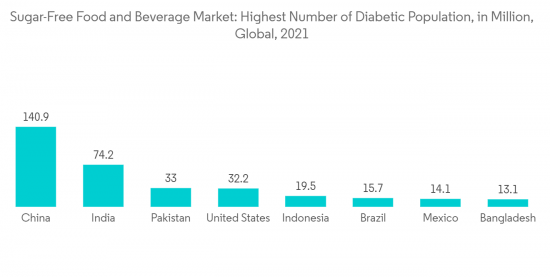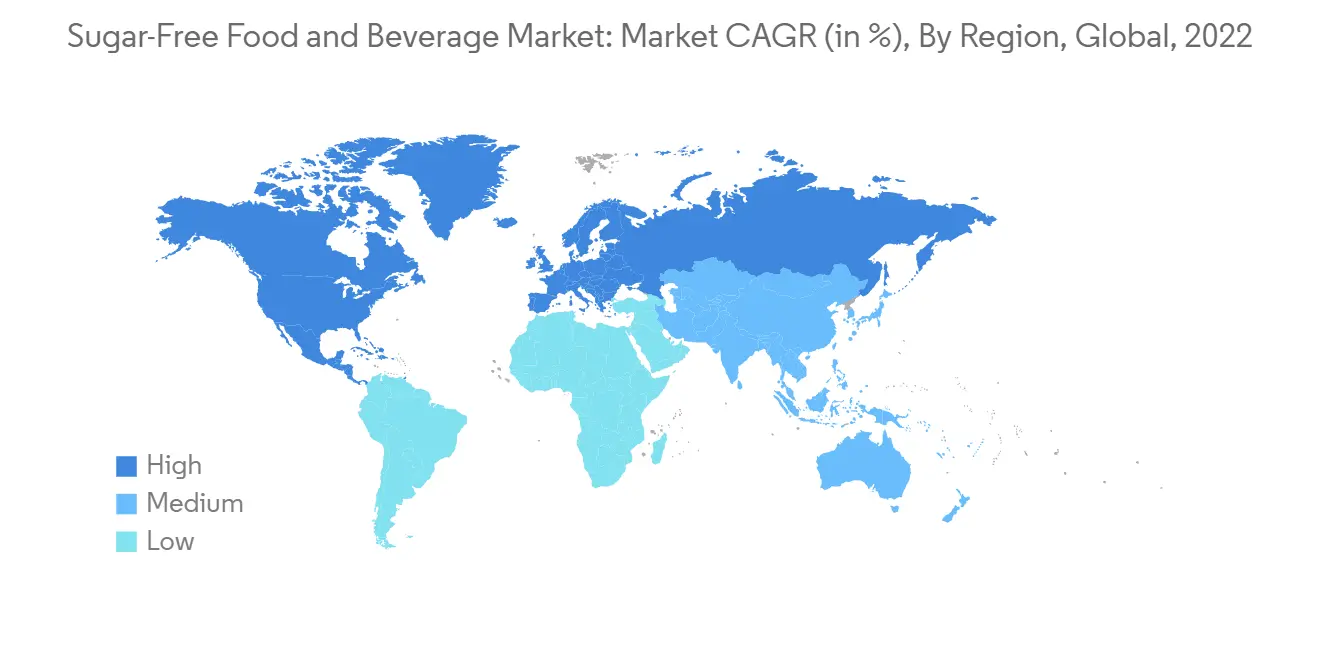
|
市場調査レポート
商品コード
1333722
無糖食品と飲料の市場規模&シェア分析:成長動向と予測(2023~2028年)Sugar-Free Food And Beverage Market Size & Share Analysis - Growth Trends & Forecasts (2023 - 2028) |
||||||
カスタマイズ可能
適宜更新あり
|
|||||||
| 無糖食品と飲料の市場規模&シェア分析:成長動向と予測(2023~2028年) |
|
出版日: 2023年08月08日
発行: Mordor Intelligence
ページ情報: 英文 130 Pages
納期: 2~3営業日
|
- 全表示
- 概要
- 目次
無糖食品と飲料市場規模は、予測期間(2023年~2028年)にCAGR 3.98%で、2023年の191億7,000万米ドルから2028年には233億米ドルに成長すると予測されます。
主なハイライト
- 不適切に加工された食品を食べることの悪影響について参考資料が増えるにつれて、人々は体に入れるものをより選ぶようになっています。従来型から健康志向への移行は、生産者に斬新で高品質な商品ラインナップの拡大を促しています。乳製品、乳糖、グルテン、砂糖不使用を謳う製品は、最も広く出回る傾向にあります。
- 例えば、2021年2月、ハルサは24オンスファミリーサイズのプレーン無糖オートミルクヨーグルトを追加し、製品ラインを拡大しました。新しい糖質ゼロのオートミルクヨーグルトは、1食あたりのカロリーがわずか90%で、ヘルシーなプロバイオティックスムージー、ディップ、ソース、サラダドレッシング、その他多くの植物性レシピを家庭で作るためのベースとして複数の用途があります。
- 糖尿病と過体重・肥満の増加により、消費者は砂糖から離れ、砂糖不使用の代替食品へと向かっています。どちらの症状も蔓延しています。米国心臓協会では、糖尿病や肥満の予防のために、女性には1日小さじ6杯以下の砂糖を加えることを推奨しています。
- さらに、砂糖が少なければ糖化を防ぐことができます。その結果、肥満は多くの国で総医療費のかなりの割合を占めています。経済協力開発機構(OECD)の分析によると、米国では2020年から2050年にかけて、過体重とその関連疾患に費やされる医療費の割合が14%を占めると予測されています。
- さらに、低カロリー飲料に対する需要の高まりと、それに伴う砂糖代替品を使用することによるコスト削減の利点が、おそらく無糖食品と飲料市場の成長の最大の理由であると考えられます。砂糖不使用製品に対する需要の高まりは、菜食主義や植物ベースの食生活が受け入れられつつあることにも起因しているかもしれないです。こうした食生活を実践する人々は、動物性原料を一切使用せず、糖分含有量の少ない食品・飲料を求めることが多いです。食品・飲料業界の企業は、より多くの砂糖不使用の選択肢を発売することで、この動向に対応しています。
無糖食品と飲料市場の動向
生活習慣病に対する関心の高まり
- 食品と飲料には多くのカロリーと糖分が含まれています。このため、健康志向の消費者は低カロリー・無糖食品を摂取しようとしています。一方、肥満の蔓延が増加していることから、予測期間中、無糖食品と飲料の売上が増加すると予想されます。過去10年間で、過体重と肥満の有病率は増加しています。
- 米国などの北米諸国では、米国疾病予防管理センター(Centers for Disease Control and Prevention)のデータによると、18歳以上の人口の31.9%が過体重であることが記録されています。砂糖を含む製品は高カロリーであるため、同市場ではジュース、ビスケット、乳製品など、砂糖無添加または砂糖不使用の製品を好む消費者が多いです。同様に、この地域における糖尿病人口の増加が、無糖食品と飲料の売上をさらに押し上げています。
- 国際糖尿病連合(IDF)によると、2021年には北米とカリブ海地域の5,100万人が糖尿病を患っています。そのため、糖尿病人口の増加は、ビスケット、クッキー、マフィンなどの無糖ベーカリー製品に傾斜しています。
- 砂糖の摂取量を減らすことの利点には、減量や肥満防止に役立つこと、2型糖尿病や糖尿病予備軍のリスクを下げること、過敏性腸疾患やクローン病などの炎症性消化器疾患のリスクを下げることなどがあります。低炭水化物飲料は、持続的なエネルギーを提供し、代謝状態を促進するよう設計されています。そのため、この要因が市場の成長を後押ししています。魅力的なパッケージによる新製品のイノベーションは、プレーヤーが採用する主な戦略です。
- 例えば、2021年9月、モンデリーズ・インターナショナルは中国で砂糖不使用のオレオの新ラインを発売しました。このオレオ・ビスケットには、ショ糖とブドウ糖の代わりにマルチトールが含まれています。販売されているのは、「クラシック」オレオ味とバラ味のオレオ・ゼロ薄焼きビスケットの2品で、サクサクした食感で花のような味がします。

北米が最大市場
- 世界保健機関(WHO)の調査によると、ファーストフードの売上高は肥満度の上昇と相関関係があり、アメリカ人はファーストフードが大好きです。肥満や糖尿病に対する関心が高まるにつれ、より健康的な食品と飲料への需要が高まっています。リサーチ・アメリカが実施した調査によると、2022年には米国で約5%と3%の人々が肥満と糖尿病に苦しんでおり、米国で無糖食品と飲料市場の有望な需要を生み出しています。
- そのため、米国の消費者は砂糖不使用のコンセプト商品を非常によく受け入れました。そこでメーカー各社は、多様な需要に対応し消費者基盤を強化するための主要戦略として、製品のリポジショニングとレシピの検証を開始しました。例えば、2022年3月、スポーツ栄養とライフスタイルブランドの栄養補助食品をリードする世界的プロバイダーであるマッスルファーム社は、複数の砂糖不使用フレーバーで20g以上のタンパク質を含む高ホエイタンパク飲料ライン(Ready-To-Drinkプロテイン飲料)を発売しました。
- ほとんどの食品カテゴリーは市場が確立しており、フリーフロム食品の量的成長の余地は大きいです。市場の主要企業は、新商品の提供と国内でのプレゼンス拡大に注力し、より多くの顧客層を惹きつけています。これらのプレーヤーは、植物由来の食品と飲料に砂糖無添加を提供し、ビーガンや砂糖不使用の代替品に対する消費者のニーズの高まりに対応しています。
- 例えば、2021年2月、乳製品不使用のココナッツミルクアイスクリーム会社Nadamoo!は、米国で砂糖無添加フレーバーのアイスクリームを発売しました。新商品はバニラ、チョコレート、ミントチップ、ストロベリーの4つのフレーバーが用意されました。同社はまた、この製品が非遺伝子組み換えでグルテンフリーであることも主張しています。

無糖食品と飲料業界の概要
世界の無糖食品と飲料市場は競争が激しく、世界中に多くのプレーヤーが存在します。研究開発活動や製品革新への投資が高く、世界市場で大きなシェアを獲得しています。市場の主要企業には、ハーシー・カンパニー、ネスレS.A.、ペプシコ、マース・インコーポレイテッド、ケロッグ・カンパニーなどがあります。
主要企業は、自社のポートフォリオを拡大し、地域の消費者の関心に応えるために、市場での合併・買収に乗り出しており、新たな主要ブランドの獲得に注力しています。また、ソーシャルメディア・プラットフォームやキャンペーンを利用して、製品のマーケティングや販売促進を行っている企業もあります。例えば、2022年3月にCoca-Cola India社は、新ブランドCoca-Cola Zero Sugarのキャンペーンを開始しました。
その他の特典
- エクセル形式の市場予測(ME)シート
- 3ヶ月間のアナリスト・サポート
目次
第1章 イントロダクション
- 調査の前提と市場定義
- 調査範囲
第2章 調査手法
第3章 エグゼクティブサマリー
第4章 市場力学
- 市場促進要因
- 市場抑制要因
- ポーターのファイブフォース分析
- 供給企業の交渉力
- 買い手・消費者の交渉力
- 新規参入業者の脅威
- 代替品の脅威
- 競争企業間の敵対関係の強さ
第5章 市場セグメンテーション
- 製品タイプ
- 飲料
- 乳製品と代替乳製品
- 菓子類
- ベーカリー製品
- 栄養補助食品
- その他の製品タイプ
- 流通チャネル
- スーパーマーケット/ハイパーマーケット
- コンビニエンスストア
- 薬局/ドラッグストア
- オンライン小売店
- その他の流通チャネル
- 地域
- 北米
- 米国
- カナダ
- メキシコ
- その他北米地域
- 欧州
- スペイン
- 英国
- ドイツ
- フランス
- イタリア
- ロシア
- その他欧州
- アジア太平洋
- 中国
- 日本
- インド
- オーストラリア
- その他アジア太平洋地域
- 南米
- ブラジル
- アルゼンチン
- その他南米
- 中東・アフリカ
- 南アフリカ
- サウジアラビア
- その他中東とアフリカ
- 北米
第6章 競合情勢
- 最も採用されている戦略
- 市場シェア分析
- 企業プロファイル
- The Hershey Company
- Nestle SA
- The Kellogg Company
- Mars, Incorporated
- PepsiCo Inc.
- The Coca-Cola Company
- The Kraft Heinz Company
- Hostess Brands, Inc.
- Mondelez International Inc.
- Strauss Group Ltd
- Meadbery
第7章 市場機会と今後の動向
The Sugar-Free Food And Beverage Market size is expected to grow from USD 19.17 billion in 2023 to USD 23.30 billion by 2028, at a CAGR of 3.98% during the forecast period (2023-2028).
Key Highlights
- As people have learned more about the negative effects of eating improperly processed food, they have become more selective about what they put in their bodies. The move from a conventional to a health-conscious outlook has encouraged producers to expand their product lines with novel, high-quality goods. Products that claim to be dairy, lactose, gluten, or sugar-free tend to be the most widely available.
- For instance, in February 2021, Halsa expanded its product line with the addition of 24oz family-size plain unsweetened zero Sugar oat milk yogurt. The new zero-sugar oat milk yogurt has only 90% calories per serving and has multiple uses as a base for making healthy probiotic smoothies, dips, sauces, salad dressings, and many other plant-based recipes at home.
- Mounting incidences of diabetes and overweight/obesity are pushing consumers from sugar and toward sugar-free alternatives. Both conditions are prevalent. The American Heart Association recommends no more than six teaspoons of added sugar a day for women to be safe from diabetes and obesity.
- Moreover, less sugar prevents glycation. Consequently, obesity caters to a significant percentage of total health expenditure in many countries. According to the analysis of the Organization for Economic Co-Operation and Development (OECD), the percentage of health expenditure spent on overweight and related conditions is predicted to account for 14% in the United States from 2020 to 2050.
- Moreover, the increasing demand for low-calorie beverages and the associated cost-cutting advantage of using sugar substitutes is perhaps considered to be the foremost reason for the growth of the sugar-free foods and beverages market. The growing demand for sugar-free products might also be attributed to the increasing acceptance of veganism and plant-based diets. People who adhere to these diets often search for food and drink options that don't contain any animal ingredients and have low sugar content. Companies in the food and drink industry are responding to this trend by releasing more sugar-free options.
Sugar-Free Food and Beverage Market Trends
Rising Concern About Lifestyle Diseases
- Food and beverage products contain many calories and sugar content. Owing to this factor, health-conscious consumers try to consume low-calorie and no-sugar food products. Meanwhile, the increasing prevalence of obesity is anticipated to increase the sales of sugar-free food and beverages in the market over the forecast period. Over the last decade, the prevalence of overweight and obesity has increased.
- North American countries such as the United States recorded 31.9% population aged 18 and over being overweight as per the Centers for Disease Control and Prevention agency data. As sugar-containing products are high in calories, several consumers in the market prefer no added sugar or sugar-free products like juices, biscuits, dairy products, and others. Similarly, the increasing diabetic population in the region is further driving the sales of sugar-free food and beverages.
- According to the International Diabetes Federation (IDF), in 2021, 51 million people in North America and the Caribbean lived with diabetes. Thus, the increasing diabetic population is inclining toward sugar-free bakery products like biscuits, cookies, muffins, etc.
- Some of the benefits of reducing sugar intake include it helps in losing weight and preventing obesity, lowers the risk of type 2 diabetes or pre-diabetes, and reduces the risk for inflammatory digestive conditions such as irritable bowel disease and Crohn's disease. The low-carb beverages are designed to provide sustained energy and help accelerate the metabolic state. Therefore this factor is driving the growth of the market. New product innovation with attractive packaging is the main strategy adopted by players.
- For instance, in September 2021, Mondelez International launched a new line of sugar-free Oreos in China. The Oreo biscuits contain maltitol instead of sucrose and glucose. Two products on sale are the "classic" Oreo flavor and rose-flavored Oreo zero thin biscuits that have a floral taste with a crispy texture.

North America Holds Largest Market
- The World Health Organization (WHO) found that a rise in fast food sales is correlated to a rise in body mass index, and Americans are very much fond of fast foods. Rising concerns regarding obesity and diabetes through extensive awareness means consecutively generating the demand for healthier food and beverage products in the market. In 2022 around 5% and 3% of people in the United States are suffering from obesity and diabetes, according to a survey conducted by Research America, creating a promising demand for sugar-free food and beverage market in the United States.
- US consumers, therefore, accepted the sugar-free concept offerings very well. So the manufacturers commenced repositioning and validating the recipe of the products as the primary strategy to serve the diverse demands and strengthen the consumer base. For instance, in March 2022, MusclePharm, a global provider of leading sports nutrition and lifestyle branded nutritional supplements, launched a high whey protein drink line (Ready-To-Drink protein drink) with over 20 g of protein in multiple sugar-free flavors.
- Most food product categories have established markets, and there is great room for volume growth of free-from food products. The key players in the market are focused on offering new products and expanding their presence in the country, attracting a larger customer base. These players offer no added sugar in plant-based food and beverages, catering to the growing consumer requirement for vegan and sugar-free alternatives.
- For instance, in February 2021, Nadamoo!, a dairy-free coconut milk ice cream company, launched its no added sugar flavors of ice creams in the United States. The new products were available in four flavors: vanilla, chocolate, mint chip, and strawberry. The company also claimed the product to be certified non-GMO and gluten-free.

Sugar-Free Food and Beverage Industry Overview
The global sugar-free food and beverages market is highly competitive, with the presence of many players across the world. High investments in R&D activities and product innovation have led them to gain a major market share in the global market. Some of the key players in the market include The Hershey Company, Nestle S.A, PepsiCo, Mars Incorporated, and the Kellogg Company.
The key players are embarking on mergers and acquisitions in the market to expand their portfolio and cater to the interests of local consumers, and concentrate on acquiring new leading brands. Some of the players are also using social media platforms and campaigns for marketing and promoting their products. For instance, in March 2022. Coca-Cola India launched a new campaign for its new brand Coca-Cola Zero Sugar.
Additional Benefits:
- The market estimate (ME) sheet in Excel format
- 3 months of analyst support
TABLE OF CONTENTS
1 INTRODUCTION
- 1.1 Study Assumptions and Market Definition
- 1.2 Scope of the Study
2 RESEARCH METHODOLOGY
3 EXECUTIVE SUMMARY
4 MARKET DYNAMICS
- 4.1 Market Drivers
- 4.2 Market Restraints
- 4.3 Porter's Five Forces Analysis
- 4.3.1 Bargaining Power of Suppliers
- 4.3.2 Bargaining Power of Buyers/Consumers
- 4.3.3 Threat of New Entrants
- 4.3.4 Threat of Substitute Products
- 4.3.5 Intensity of Competitive Rivalry
5 MARKET SEGMENTATION
- 5.1 Product Type
- 5.1.1 Beverage
- 5.1.2 Dairy and Dairy Alternatives
- 5.1.3 Confectionery
- 5.1.4 Bakery Products
- 5.1.5 Dietary Supplements
- 5.1.6 Other Product Types
- 5.2 Distribution Channel
- 5.2.1 Supermarkets/Hypermarkets
- 5.2.2 Convenience Stores
- 5.2.3 Pharmacies/Drug Stores
- 5.2.4 Online Retail Stores
- 5.2.5 Other Distribution Channels
- 5.3 Geography
- 5.3.1 North America
- 5.3.1.1 United States
- 5.3.1.2 Canada
- 5.3.1.3 Mexico
- 5.3.1.4 Rest of North America
- 5.3.2 Europe
- 5.3.2.1 Spain
- 5.3.2.2 United Kingdom
- 5.3.2.3 Germany
- 5.3.2.4 France
- 5.3.2.5 Italy
- 5.3.2.6 Russia
- 5.3.2.7 Rest of Europe
- 5.3.3 Asia-Pacific
- 5.3.3.1 China
- 5.3.3.2 Japan
- 5.3.3.3 India
- 5.3.3.4 Australia
- 5.3.3.5 Rest of Asia-Pacific
- 5.3.4 South America
- 5.3.4.1 Brazil
- 5.3.4.2 Argentina
- 5.3.4.3 Rest of South America
- 5.3.5 Middle-East and Africa
- 5.3.5.1 South Africa
- 5.3.5.2 Saudi Arabia
- 5.3.5.3 Rest of Middle-East and Africa
- 5.3.1 North America
6 COMPETITIVE LANDSCAPE
- 6.1 Most Adopted Strategies
- 6.2 Market Share Analysis
- 6.3 Company Profiles
- 6.3.1 The Hershey Company
- 6.3.2 Nestle SA
- 6.3.3 The Kellogg Company
- 6.3.4 Mars, Incorporated
- 6.3.5 PepsiCo Inc.
- 6.3.6 The Coca-Cola Company
- 6.3.7 The Kraft Heinz Company
- 6.3.8 Hostess Brands, Inc.
- 6.3.9 Mondelez International Inc.
- 6.3.10 Strauss Group Ltd
- 6.3.11 Meadbery

